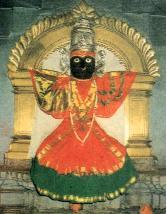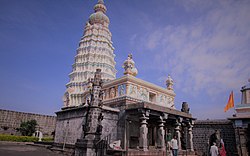| Yamai Devi | |
|---|---|
 | |
| Religion | |
| Affiliation | Hinduism |
 | |
The Yamai Devi Temple is situated in a hill complex in the town of Aundh, Satara district, Maharashtra, India.
History
[edit]


It is said that Goddess Mahalaxmi, God Jyotiba of Kolhapur and Sri Rama (Lord Vishnu) called her as "Ye Mai" (in Marathi) (ये माय / ये माई) which means "Mother, pls. come" in English. Hence, she is known as Yamai Devi. Yamai Devi is also considered the elder sister of Tulja Bhavani. Therefore, many devotees still follow the tradition of visiting the Mulpeeth Yamai Devi after visiting Tuljapur's Tulja Bhavani. Devotees are used to come with pure heart into one of the Devi Yamai's temples and to find her blessing. [1]
Temple features
[edit]The Yamai temple is built on a small hill. The top of the hill can either be reached using steps that start at the bottom of the hill, or by car. There is a parking available at the top. The temple complex has the head of Rakshas Aundhasur, a well carved Nandi and a Shivling. The idol of the goddess, Yamai in black stone is almost two metres high and is in a cross-legged sitting position.[citation needed] The temple is the family shrine (kula-daiwat) for a large number of Marathi families. The top of the temple has images and idols of various Hindu deities. The town and the temple has been associated with the PantPratinidhi family for many centuries.[2] The present head of this former ruling family, Gayatreedevi Pantpratinidhi, has installed a 7 kilograms (15 lb) solid gold kalash or crown on the pinnacle of the Yamai temple on the hill. Another temple of Devi Yamai is located in the town; apart from the one on the hill. The temple had an elephant for religious processions and ceremonies for more than fifty years. It was taken to an elephant sanctuary in 2017 because of health issues.[3]
Shri Bhavani Museum
[edit]The temple complex also houses the Shri Bhavani Museum established from the private collection of the Maharajas of Aundh. The museum building is situated on the middle section of the temple hill. Visitors can reach the museum, both by steps and road. The museum holds paintings by noted 19th and 20th century Indian artists such as M. V. Dhurandhar,[4] Baburao Painter, Madhav Satwalekar[5] and Raja Ravi Varma as well as the famous Mother and Child stone structure by the British artist Henry Moore.[6]
Major Twelve Peeth (shrines-temples) of Shri Yamai Devi in Maharashtra
[edit]Shree Yamai Devi is revered as one of the prominent goddesses of Maharashtra. There are around 60–70 small and large temples dedicated to Yamai Devi across India, primarily in the states of Maharashtra, Karnataka, and Andhra Pradesh. Among these, twelve temples hold special significance and are considered the twelve main shrines (temples) of Yamai Devi. Along with the Mulpeeth (original seat) at Aundh, several Uppeeth (subsidiary shrines) dedicated to the goddess have been established across the state for the purpose of destroying evil forces and ensuring the welfare of devotees. These subsidiary shrines are considered as sacred and significant as the original seat. The twelve major Mulpeeth and Uppeethas (12 popular Shrines-Temples of Yamai devi) are as follows:
1. MULPEETH (Original Seat - Main Shrine - Temple of Shree Yamai devi) : Shree Mulpeeth Yamai Devi Devasthan, Shree Kshetra Aundh (Mulpeeth), Taluka Khatav, District Satara.
UPPEETH (Major Subsidiary Shrines-Temples of Shri Yamai Devi) :
2. Shree Jagdamba Yamai Devi Devasthan, Shree Kshetra Rashin, Taluka Karjat, District Ahmednagar.
3. Shree Yamai Devi Devasthan, Shree Kshetra Jyotiba Dongar (Wadi Ratnagiri), Taluka Panhala, District Kolhapur.
4. Shree Yamai Devi Devasthan, Shree Kshetra Mardi, Taluka North Solapur, District Solapur.
5. Shree Yamai Devi Devasthan, Shree Kshetra Kanherasar, Taluka Khed, District Pune.
6. Shree Yamai Devi Devasthan, Shree Kshetra Shivri, Taluka Purandar, District Pune.
7. Shree Yamai Devi Devasthan, Shree Kshetra Kavathe Yamai, Taluka Shirur, District Pune.
8. Shree Sakharagadnivasini Ambabai – Yamai Devi Devasthan, Shree Kshetra Kinhai, Taluka Koregaon, District Satara.
9. Shree Yamai Devi Devasthan, Shree Kshetra Hingangav, Taluka Paranda, District Dharashiv (Osmanabad).
10. Shree Yamai Devi Devasthan, Shree Kshetra Hippargarav, Taluka Umarga, District Dharashiv (Osmanabad).
11. Shree Yamai Devi Devasthan, Shree Kshetra Mahalung, Taluka Malshiras, District Solapur.
12. Shree Yamai Devi Devasthan, Shree Kshetra Koregaon, Taluka Barshi, District Solapur.
References
[edit]- ^ "Yamai Devi: Legend behind the goddess and her temple in Aundh!". Zee Media. Apr 17, 2017. Archived from the original on April 21, 2017.
- ^ Pant, Apa (1974). A moment in time. Bombay Calcutta Madras New Delhi: Orient Longman. p. 20. ISBN 9780340147900. Retrieved 20 November 2015.
- ^ Varma, S., Sujata, S.R. and Bhanage, N., Captive Elephants of Maharashtra.[1]
- ^ Bhagwat., Nalini. "M. V. Dhurandhar". indiaart.com. Retrieved 23 December 2014.
- ^ Chaitanya, Krishna (1994). A History of Indian Painting: The modern period. New Delhi: Abhinav Publications. pp. 273–274. ISBN 81-7017-310-8.
- ^ "Shivaji designs for stained-glass windows: the art of Ervin Bossanyi. - Free Online Library". Thefreelibrary.com. Retrieved 2013-05-09.

